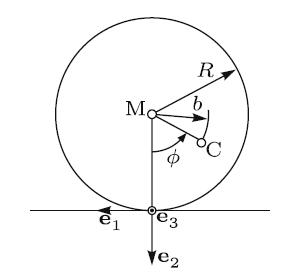In Wittenburg, "Dynamics of Multibody Systems", 2e, 2008, p.45, (3.33), the definition of time derivative of angular momentum with respect to a reference coordinate system, in its most general form, is given as
$\dot{\mathbf{L}}^0=m[\mathbf{r}_A \times \ddot{\mathbf{r}}_C + \dot{\mathbf{r}}_A \times (\dot{\mathbf{r}_A + \mathbf{\omega \times \mathbf{\rho_C}}}) + (\mathbf{\omega} \times \mathbf{\rho_C}) \times \dot{\mathbf{r}}_A + \mathbf{\rho_C} \times \ddot{\mathbf{r}}_A] + J^A \dot{\mathbf{\omega}} + \mathbf{\omega} \times J^A \mathbf{\omega},$
based on the definition of angular momentum (3.15):
$ \mathbf{L}^0 = \mathbf{r}_A \times (\dot{\mathbf{r}}_A + \mathbf{\omega} \times \mathbf{\rho}_C)m + \mathbf{\rho}_C \times \dot{\mathbf{r}}_Am + J^A \mathbf{\omega}, $
where $\mathbf{r}_A$ is an arbitrary body reference point, $\mathbf{\omega}$ is a rotation vector, $\mathbf{\rho_C}$ denotes the center of mass with respect to $A$, $m$ is the body's mass, and $J^A$ is the inertia tensor with respect to $A$.
My question:
Applying
$ d_t \mathbf{p}^{(1)} = \mathbf{\omega} \times \mathbf{p}^{(2)} + d_t \mathbf{p}^{(2)}, $
where the superscript indicates the chosen basis, $\mathbf{p}$ is an arbitrary vector, and $d_t$ is the absolute time derivative, shouldn't the absolute time derivative of the angular momentum rather be
$ \begin{eqnarray} \dot{\mathbf{L}}^0 & = & \mathbf{\omega} \times (\mathbf{r}_A \times (\dot{\mathbf{r}}_A + \mathbf{\omega} \times \mathbf{\rho}_C)m + \mathbf{\rho}_C \times \dot{\mathbf{r}}_Am + J^A \mathbf{\omega})^{(2)} + d_t (\mathbf{r}_A \times (\dot{\mathbf{r}}_A + \mathbf{\omega} \times \mathbf{\rho}_C)m + \mathbf{\rho}_C \times \dot{\mathbf{r}}_Am + J^A \mathbf{\omega})^{(2)}, \\ & = & (\omega \times \mathbf{r}_A \times \dot{\mathbf{r}}_C + \omega \times \mathbf{\rho}_C \times \dot{\mathbf{r}}_A)^{(2)}m + \omega \times J \omega \\ && + (\mathbf{r}_A \times \ddot{\mathbf{r}}_C + \mathbf{\rho}_C \times \ddot{\mathbf{r}}_A)^{(2)}m + J^A \dot{\omega} \end{eqnarray} $
where the base corresponding to $(2)$ is chosen to be a body-fixed coordinaten system? (Note that $\dot{\mathbf{r}}_A + \mathbf{\omega} \times \mathbf{\rho}_C = \dot{\mathbf{r}}_C$)
Explicitly, what about the term
$ (\omega \times \mathbf{r}_A \times \dot{\mathbf{r}}_C + \omega \times \mathbf{\rho}_C \times \dot{\mathbf{r}}_A)^{(2)}m $
that seems to be missing in the above given definition of the timely derivative of the angular momentum?
To get a grip on the problem, I worked on problem 3.5 on page 46 of the same textbook:
Problem 3.5. In Fig. 3.4 an inhomogeneous circular cylinder of radius $R$, mass $m$ and moment of inertia $J^C$ about an axis through the center of mass $C$ is shown. The center of mass is located at the radius $b$. The cylinder is rolling without slipping on a horizontal plane. Formulate the equation of motion for the angular coordinate $\phi$ by using as reference point $A$ in (3.35) (i) the center of mass $C$, (ii) the geometric center $M$ and (iii) the point of contact with the plane.
The referenced figure 3.4 is this one:
For sakes of completeness, equation (3.35) is
$ m \mathbf{\rho}_C \times \ddot{\mathbf{r}}_A + J^A \dot{\mathbf{\omega}} + \mathbf{\omega} \times J^A \mathbf{\omega} = \mathbf{M}^A, $
but I did not use it. Instead I inserted (3.33) into Euler's theorem
$ \dot{\mathbf{L}}^0 = \mathbf{r}_A \times \mathbf{F}, $
and ended up with the differential equation
$ m(\mathbf{r}_C \times \ddot{\mathbf{r}}_C) + J^C \ddot{\phi} + \dot{\phi} \times (J^C \dot{\phi}) = \mathbf{r}_C \times (-m \mathbf{g}) $
describing the cylinder's motion if the reference point $A$ is chosen to be the center of mass $C$ which corresponds to case (i) of the exercise.
I integrated the differential equation for an example of an inhomogeneous cylinder, where a quarter of the cross-section has homogeneous density $\rho_2$, and the rest has $\rho_1$.
A visualization is shown here for $\phi_0 = 0, \dot{\phi}_0 = 10$ which is below the "break-out" angular velocity. Exceeding "break-out" angular velocity makes the cylinder travel along the floor, instead of oscillating about an equilibrium state.
This result shows that (3.33) yields plausible results, but I still don't know why the extra term mentioned above cancels out.


